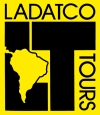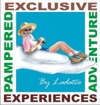

Destinations
Experiences
 |
L A
D A T C O T O U R
S |
 |
||||||||
| HOME | South America | Falkland Islands | Antarctica | Unique Destinations |
Unique Experiences |
Newsstand | ||||
 historic Las Penas |
Guayaquil Ecuador |
 Three Toed Sloth - Parque Historico |
Guayaquil (pop 1,508,000 officially but probably closer to 2,400,000) is the country is largest city and the main port and commercial city. Dotted with parks and plazas, Guayaquil sits on the west bank of the Guayas River 56 kilometers from its outflow into the Gulf of Guayaquil. Founded in 1525 and again in 1537, Guayaquil is decidedly different from its highland counterpart - not only is it hot and humid, the people tend to be more lively, more outgoing and more colorful than the Quitenos.
The rainy season is January to April and it can be hot and very humid. But from May to December the climate is pleasant with little or no rain and cool nights.
The wide, tree-lined waterfront avenue, the Malecon, runs alongside the Rio Guayas, with the exclusive Club de la Union, the Moorish Clock Tower, the Palacio Municipal and Government Palace as well as the La Rotonda statue at the begining of the city’s main boulevard, and 11 piers.
The oldest district of the city, Las Penas, at the foot of Cerro Santa Ana, is the last vestige of colonial Guayaquil. The narrow cobblestone street Numa Pompilio Llona is now occupied mainly by artists. The city’s oldest church, Santo Domingo, was originally built in 1547, sacked and burned by pirates in 1624 and rebuilt in its present classical style in 1938, stands just at the endge of Las Penas.
The Museuo Municipal has paintings, gold and archaeological artefacts, shrunken Shuar heads, a section on the history of Guayaqul. The excellent Botanical Gardens has over 3000 plants including 150 species of Ecuadorian and foreign orchids. Nearby Cerro Blanco Forest Reserve has an impressive variety of birds (190 species listed so far) and other wildlife. This private resrve has defined trails; reservations are a must. Check locally for schedules and availability.
Here is more information on some of the main places of interest in this bustling port city:
LA ROTONDA:
This historical monument is a spectacular semicircle commemorating the meeting of two Latin American liberators, Simón Bolívar and San Martin, when it was decided that Guayaquil be annexed to the Gran Colombia. The monument was designed and made by the Spanish Sculptor Jose Antonio Homs and finished in 1937. Bolivar was the famous Venezuelan liberator who brought freedom to Bolivia, Colombia and Ecuador including his own country from the Spanish crown, while San Martin was the Argentinean equivalent freeing Peru and Chile from the Spanish rule.BARRIO LAS PEÑAS:
This is the oldest area of the city with wooden houses and cobbled streets dating back to the 1500's, lined along a narrow street with various levels of stairs and steps. At the top is Plaza Colon, where the cannons that guarded the city against pirates can still be seen. Las Peñas is best viewed bathed in full illumination in the evenings, to enjoy cozy bars, cafés and restaurants. Many of the houses have plaques and old photographs showing before and after renovation pictures.MALECON 2000:
The Pier, known as Malecon 2000 has been transformed into the prettiest and most visited area of Guayaquil. This area has revived the traditional values of Ecuador, while returning the eyes of the people to the river. This new 2.5 km waterfront walk is home to entertainment, culture as well as nature.
The northern section boasts several plazas, water fountains, an antique Ecuadorian train, spaces for aerobics, skating and games for children, and will soon be home to a Planetarium, an anthropological Museum and a Contemporary Art Museum. A Fortress, complete with cannons, which served to defend Guayaquil against pirate attacks, is also available to explore.
The central area of the waterfront walk is home the historic Civic Plaza with its sculptures, Rotonda Monument and the Moorish Clock Tower. The Guayaquil Yacht Club and the Naval Yacht club can also be found here.
The ultramodern Bahia Malecon Shopping Center is located in the southern part of the walk. Strollers can stop and enjoy the terraces, restaurants and a spectacular view of the river. The Old South Market is being renovated to house a handicrafts market.METROPOLITAN CATHEDRAL:
The Cathedral was originally built in wood in 1547, but fire consumed its structures more than once and it has been rebuilt several times. The present neo-gothic style building was inaugurated in 1948. It has impressive glass work windows and a marble altar, brought from Cuenca. The Cathedral is located on Chimborazo and Clemente Ballén streets, opposite Simon Bolivar ParkHISTORICAL.THE PARK OF GUAYAQUIL (PARQUE HISTORICO):
Located across the Guayas River, the Parque Historico has an excellent wildlife area in addition to the historical and traditions areas. The Historical Park is divided in 3 zones:
- Wildlife: The first area consist of 4 hectares (40.000 m2), an ample space for more than 50 species of birds, mammals and reptiles, not counting insects, crustaceans, fish and other animals found in this piece of protected mangrove forest which is their natural habitat, where the animals live in an almost free environment. The area of Wildlife is visited along raised boardwalk paths that allow close contact with the ecosystem without disturbing the animals. Along the way there are 23 informative stops which allow individualized observation of each species. The observation tower allows visitors to a bird's eye view of the park, and bird nesting sites along the path complement the visit.
- The Urban Architecture Area recreates a time of wealth in Guayaquil, when the cocoa beans exportations brought prosperity to the city and surrounding farms. During weekends, you can also observe the daily life of Guayaquil, with persons dresses in the French fashion that was so popular at the time, street vendors of sweets and tobacco. Also recreated is the electric tramway which was pulled by mules.
After the big fire in 1896 that practically destroyed all of Guayaquil, the city was rebuilt and modernized with the houses that can be seen, like the house of Julián Coronel, Banco Territorial, Casa Lavayen-Paredes (Green House) and the Hospice Corazón de Jesús which were rescued as cultural patrimony, and moved to this park.
The Banco Territorial was built in 1886 and used as a bank. The structure and second floor were made out of wood; zinc was used in the façade and bricks on the first floor.
The Hospice was built in 1892 for social assistance. Wood and bricks were used on the first floor and wood was used on the second floor.
Once the building is fully restored, the bell tower will be used for viewpoint and the chapel is to be used for especial events. The remaining spaces (cloisters) on the first floor, as well as on the second floor, will be used for art exhibitions. Some of these include: the city, gallery of Guayaquilean presidents, history of the building and the restoration process, temporary exhibition rooms, and a museum for children.
Built in 1896, "La Casa Verde" was used as a residence. The first floor will have shops, craft workshops, an exposition room with the history of the building including its rescue and restoration.
A customary museum will be built on the second floor exhibiting furniture, tools and other objects.
The house of Julian Coronel was built during 1899 and 1900 with the second floor used for residential purposes while the first floor was used for commercial establishments. Wood and bricks were used on the first floor and wood was also used on the second floor.
The first floor will have a coffee shop and a restaurant. An exposition room with the history of the building including its rescue and restoration process will be located on the second floor.
Museums, restaurants and coffee shops, bank agencies, traditional workshops, audiovisual and exhibition room can also be observed.
- The area of the Traditions is where you can meet the past and observe the life in the rural haciendas during the time of the boom of the cocoa production - which was known as the "Golden Seed". Visitors are led through a cocoa producing hacienda to see the whole process from the plants to the finished chocolate. Ecuador's economy was very rich, based on the agriculture exportation and production of cocoa. Handcrafting was also part of the farmers daily routine.
MUNICIPAL MUSEUM OF GUAYAQUIL:
The Museo Municipal features four halls, the first displaying archaeology pieces, information about Guayaquil´s first inhabitants and the origin of its name. The second hall deals with the Colonial times and the struggles for the emancipation of Guayaquil; the third hall with the beginning of the republic and revolutions of the same period, the last one the end of the XIX and the beginning of the XX century.MUSEUM OF ANTHROPOLOGY AND CONTEMPORARY ART (MAAC):
At Malecón 2000. The exhibits at this Museum are called:Millenary Traditions of the Ecuadorian Coast
The purpose of this exhibit is to inform the community of the ongoing efforts of national and international scholars dedicated to the interpretation of the lifestyle and philosophy of the Pre-Columbian peoples of the Ecuadorian Coast. The exhibit presents extraordinary evidence which offers vivid testimony to 10,000 years of cultural history, brought to life through the use of up-to-date electronic and computerized media and multimedia. A variety of technologies belonging to the millenary cultural tradition of the Ecuadorian Coast is displayed in the Ethnographic Exhibit, where the centerpiece is a scale-sized Manteño-Huancavilca balsa raft. This remarkable vessel was the means of transportation and commerce used by the Pre-Hispanic aboriginal peoples of Coastal Ecuador and other countries.
Permanent Contemporary Art Exhibit
An overview of 20th Century Ecuadorian Art, this exhibit offers viewers a clear historical perspective of the evolution of Ecuadorian painting since the turn of the century, showing the contributions and characteristic responses of four generations of Ecuadorian artists to the social, political, and economic changes taking place in contemporary Ecuador and the world between 1900 and 1980. In virtual galleries, it offers examples of the current work of the artists whose works represent ongoing developments in Ecuadorian Art.MUSEUM OF GOLD AT THE HOUSE OF CULTURE:
This museum holds the most valuable prehistoric gold work collection in Ecuador. Most pieces were made by the ancient inhabitants of Ecuador's coast. On display are ceremonial pots, snake-shaped bracelets, nose rings, gold pieces that were used on the lips and cheeks, elaborate pins used to fasten clothing, chest shields, ceremonial masks, earrings and much more. There are also archaeology pieces such as "Ocarinas" (clay whistles), stone head rests, molds for gold masks and clay seals, some with market Asian influence.